Basic Electronics Multiple choice Question with Answers
Questions
PART 1
1. An electric battery supplies AC current.
- True
- False
2. What device converts light energy to electrical energy?
- Dynamo
- Solar cell
- Light Polarizer
- Turbine
3. Which device converts electrical energy to light energy?
- LED
- LCD
- LDR
- None of these
4. What device is used to store electrical energy in an electric field?
- Generator
- Battery
- Capacitor
- Field-effect transistor
5. The device which converts sound energy to electrical energy?
- Mic
- Speaker
- Amplifier
- Modulator
6. Which is the instrument used to measure electrical power?
- Voltmeter
- Wattmeter
- Ammeter
- Galvanometer
7. Electrons are positively charged particles.
- True
- False
8. A good conductor should have low resistance.
- True
- False
9. What is the full form of CRO?
- Collector-ray oscilloscope
- Collector-reel oscilloscope
- Cathode-ray oscilloscope
- Cathode-ray optics
10. Find the odd one out.
- Solar Panel
- Battery
- DC Generator
- Incandescent Lamp
PART 1 – Answers
| 1 – B | 2 – B | 3 – A | 4 – C | 5 – A | 6 – B | 7 – B | 8 – A | 9 – C | 10 – D |
Explanation to selected questions
10. D – Incandescent Lamp: All other devices converts other forms of energies into electrical energy (generates electricity) whereas an incandescent lamp converts electrical energy to light energy.
PART 2
1. Pick the Odd one out
- Resistors
- Capacitors
- Inductor
- Transistor
2. The device which converts AC into DC is called?
- Amplifier
- Oscillator
- Rectifier
- Filter
3. Which one is the main electronic component in a rectifier circuit?
- Capacitor
- Diode
- Light Emitting Diode
- Resistor
4. How many terminals does a BJT (Bipolar Junction Transistor) have?
- 3 Terminal
- 2 Terminal
- 1 Terminal
- 4 Terminal
5. According to Ohms Law, the voltage drop across a resistor, V =? ( I – Current, R- Resistance, V – Voltage drop, P – Power)
- V = I / R
- V = P/ R
- V = P * R
- V = I R
6. Which one is a semiconductor element?
- Porcelain
- Silicon
- Silver
- Copper
7. What is the unit of electrical resistance?
- Ampere
- Volt
- Ohms
- Farad
8. Current through a Resistor is directly proportional to its resistance.
- True
- False
9. In which circuit the LED will ON?
A.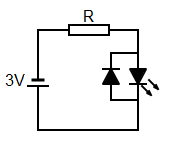 B.
B.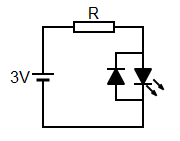
C. 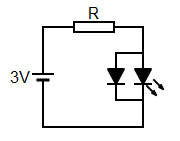 D.
D.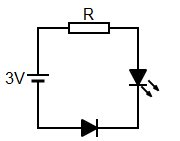
10. An inductor stores energy in the form of ___________ .
- Magnetic field
- Static electricity
- Electric field
- Light field
PART 2 – Answers
| 1 – D | 2 – C | 3 – B | 4 – A | 5 – D | 6 – B | 7 – C | 8 – B | 9 – B | 10 – A |
Explanation to selected questions
- D – Transistor: Transistor is an active component, rest are passive components.
PART 3
1. Amplification factor (β) of a common emitter transistor is? (Ic – Colelctor current, Ib – Base current, Ie – Emitter current)
- β = Ic/Ib
- β = Ie/Ib
- β = Ib/Ic
- β = Ic/Ie
2. How many depletion layers are there in a transistor ?
- Four
- One
- Three
- Two
3. Leakage current of a diode __________ with increase in temperature.
- Remains constant
- Decreases
- Increases
- None of the above
4. The collector of a Transistor is _________ doped.
- Moderately
- Heavily
- Lightly
- None of these
5. The capacitive reactance is directly proportional to the frequency of the applied AC signal.
- True
- False
6. _______ is a device that changes Direct current (DC) to Alternating current (AC).
- Voltage regulator
- Rectifier
- Inverter
- Filter
7. In a P-N junction diode no mobile charge carriers are present in the _____________.
- N region
- P region
- Depletion region
- None of these
8. Extrinsic semiconductors are pure semiconductors.
- True
- False
9. Silicon controlled rectifier (SCR) is a member of ________________ family.
- Resistor
- Transistor
- Diode
- Thyristor
10. The ratio of the strength of the desired signal to that of the unwanted interference signal is called as __________.
- SNR
- Attenuation
- Gain
- Bit Error Rate
PART 3 – Answers
| 1 – A | 2 – D | 3 – C | 4 – A | 5 – B | 6 – C | 7 – C | 8 – B | 9 – D | 10 – A |
Explanation to selected questions
5.B – False, because capacitive reactance is inversely proportional to the frequency.
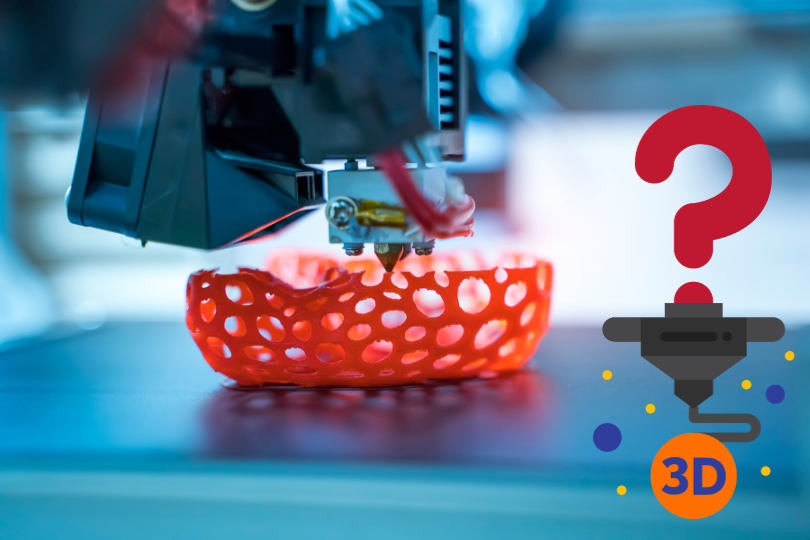 The world of hobby 3D printing: Can non-techies make it?
The world of hobby 3D printing: Can non-techies make it? Solving any problems: Apply this simple technique
Solving any problems: Apply this simple technique How to overcome Laziness: The Japanese Kaizen 1 minute method
How to overcome Laziness: The Japanese Kaizen 1 minute method 5 simple Tips to fall asleep early at night
5 simple Tips to fall asleep early at night